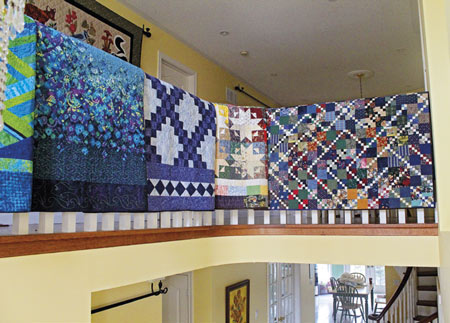Quilting
Hanging Sleeves
Elaine’s Tech Tips™
There are numerous ways to put a sleeve on the back of a quilt. Here are two ways to put sleeves on a quilt – one is permanent, the other is temporary. Permanent sleeves are best on a quilt or wall hanging that will be used as a wall hanging, while temporary sleeves are good for quilts that need to be hung for a short time like an exhibit or a quilt show.
Instead of running a sleeve along the entire width of the quilt, I like to leave a space in the centre of the sleeve in the event that the quilt needs to have an extra support bracket or the quilt is small enough that one can use a piece of lath with a centre hole to hang the quilt. If the sleeve does not have a slit in the back, then you’ll be obliged to use a nail at either end of the lath rather than just one in the centre.
Measure the width of the quilt. The edges of the finished sleeve should be about one inch narrower than the width of the quilt so the sleeve is not visible from the front. Let’s say that the finished width of the quilt is 25″, I will make two hangers, both of them measuring 11″. This allows one inch in the middle between the two hangers and one inch on either side.
Add ½” to the 11″ length of sleeve to allow for the ends to be hemmed. Cut a strip(s) of fabric that is the length determined above and 9″ wide. The width of sleeve for a smaller quilt can be cut 4½”. The larger the dowel or lath supporting the quilt, the larger the sleeve needs to be. For a large quilt, use a sleeve that measures 9″ wide and for smaller quilts, use a 4½” piece of fabric.
Read more in our Summer 2013 issue.
Article by Elaine Theriault
crazyquilteronabike.blogspot.com
Bio: Elaine made her first quilt at the tender age of 13. The urge to quilt resurfaced when her daughter moved from a crib. The rest is history – she now teaches several days a week, makes quilts on commission and quilts for others on the long-arm.

